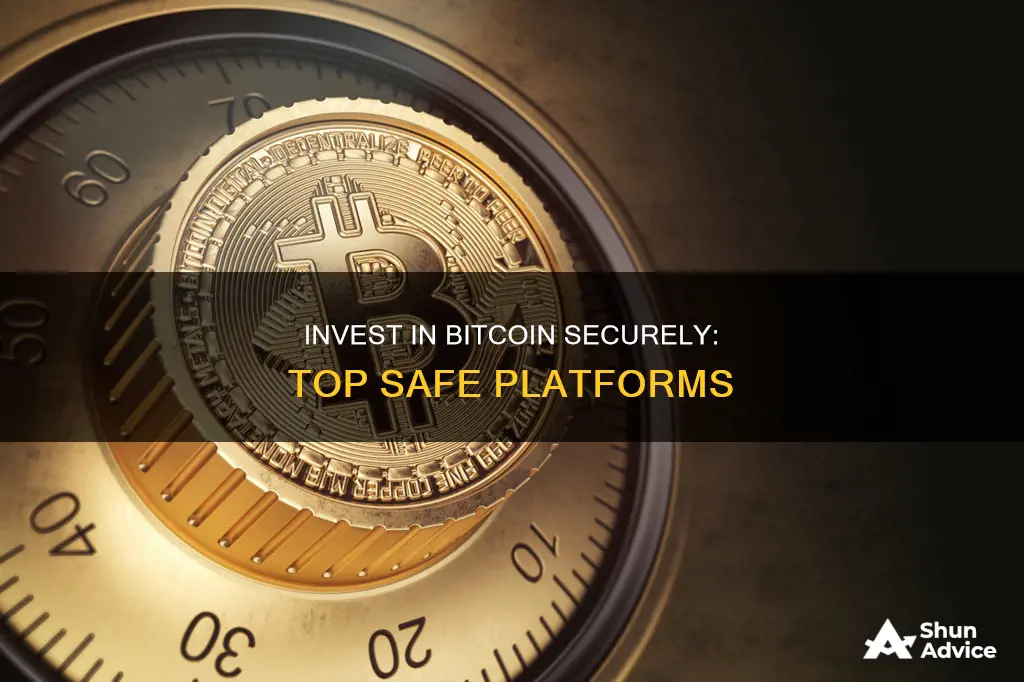
Bitcoin is a decentralised digital currency that operates without the oversight of banks and governments. It is one of the most widely used types of cryptocurrency, with virtual coins or tokens used instead of physical cash.
There are several ways to invest in Bitcoin, each with its own advantages and risks. Here are some of the most common methods:
- Bitcoin Wallets and Cryptocurrency Exchanges: You can purchase Bitcoin from cryptocurrency exchanges such as Gemini, Kraken, Coinbase, and Crypto.com. These exchanges carry different fees and consumer protections, so it is essential to do your research before choosing one.
- Traditional Stockbrokers: Some traditional brokers, like Robinhood, Webull, TradeStation, and Fidelity, offer their customers the ability to buy and sell Bitcoin. However, the choices among traditional brokers are currently limited.
- Money Transfer Apps: Cash transfer services like PayPal, Venmo, or Cash App allow users to purchase, store, send, and sell Bitcoin directly through their apps.
- Bitcoin ATMs: Bitcoin ATMs act like in-person Bitcoin exchanges, where individuals can insert cash to purchase Bitcoin, which is then transferred to their online wallets.
- Bitcoin Exchange-Traded Funds (ETFs): Bitcoin ETFs allow investors to invest in Bitcoin through a regulated stock market environment. These ETFs can be based on futures contracts or track the current market price of Bitcoin.
When investing in Bitcoin, it is crucial to understand the risks involved. Bitcoin is a very high-risk and volatile investment, prone to rapid and significant price swings. Its value is dependent on market demand, and there is no central regulator to ensure stability. Additionally, Bitcoin is subject to security risks, such as scams and fraudulent activities. As such, it is essential to only invest what you can afford to lose and to diversify your investment portfolio.
| Characteristics | Values |
|---|---|
| Investment methods | Direct purchase, Exchange-traded funds (ETFs), Crypto-related stocks, Greyscale's Bitcoin Investment Trust, Amplify Transformational Data Sharing ETF, Bitwise 10 Private Index Fund |
| Investment size | No minimum, but experts recommend not investing more than you can afford to lose |
| Risk level | High |
| Investment timescale | Short-term, Long-term |
| Investment strategy | Buy and 'Hodl', Hold long-term, Trade on short-term volatility |
| Storage | Hot wallet, Cold wallet |
What You'll Learn

Choosing a Bitcoin exchange
There are several different ways to invest in Bitcoin, both directly and indirectly. When buying Bitcoin, most investors use cryptocurrency exchanges. There is no official "Bitcoin" company as it is an open-source technology, but there are several different exchanges that facilitate Bitcoin transactions. These exchanges are the middlemen of cryptocurrency investing, like a stock brokerage.
If you decide to purchase from an exchange, you will have to decide which exchange you want to buy from. Here are some of the most popular options:
- Coinbase: A very popular crypto exchange that insures losses in the event of a security breach or fraudulent transfers
- Binance: Founded in 2017, Binance is a crypto exchange with a strong focus on altcoins
- Kraken: This San Francisco-based exchange allows you to invest in Bitcoin using various currencies from around the world
- Gemini: Launched in 2015 by Cameron and Tyler Winklevoss, Gemini offers services for casual and veteran Bitcoin investors with different user interfaces and fee structures
- Bitfinex: The longest-running cryptocurrency exchange that’s optimized for advanced traders and lenders (unfortunately, Bitfinex doesn't currently accept US customers)
As you might have guessed, choosing a Bitcoin exchange is becoming more difficult for investors as more options begin to popularize.
- Research the exchange before signing up: In the past, some cryptocurrency exchanges have suffered damaging attacks from hackers. Consider choosing an exchange that follows Know Your Customer (KYC) and Anti Money Laundering (AML) guidelines. Many popular crypto exchanges, such as Coinbase, require customers to verify information about themselves before they gain access to certain trading features.
- Compare fees: Cryptocurrency exchanges carry a variety of different fees. Do your due diligence before choosing an exchange by comparing their fees and consumer protections.
- Check for security features: The safer online platforms tend to ask you to prove your identity and have strong security features.
- Check for regulatory compliance: With so many world governments weighing how to react to crypto's rise, regulatory compliance is a key factor that may contribute to crypto's volatility moving forward.
The Golden Age of Bitcoin Investment
You may want to see also

Getting a Bitcoin wallet
A hot wallet is operated by either your cryptocurrency exchange or provider. Some exchanges will automatically provide you with a hot wallet when you open an account. Hot wallets are convenient because you will be able to access your coins through the internet or a software program. However, they are not the most secure form of coin storage. If the hot wallet provider is hacked, your coin information may be at risk. Some notable hot wallets include Electrum and Mycelium.
A cold wallet is the safest storage method for your coins. It is an actual piece of hardware that stores your coins, usually a portable device similar to a flash drive. Most cold wallets cost between $60 and $100. Some popular cold wallets include Ledger Nano X, Ledger Nano S, and Trezor Model T.
If you are only going to purchase small amounts of Bitcoin, then you might be fine using a hot wallet with an insured crypto exchange. But if you are going to be trading large amounts, then a cold wallet would be a worthwhile investment.
UK Guide: Investing Money in Bitcoin
You may want to see also

Connecting your wallet to a bank account
Step 1: Navigate to the "Add Account" Screen
On your dashboard, swipe left until you reach the end of your accounts. Swipe left once more, and you will see the "Add Account" screen. Click on the (+) button to initiate the process of adding a new account.
Step 2: Select "Connect to Bank"
Under Premium accounts, you will find the "Connect to bank" option. This will allow you to link your bank account to your wallet.
Step 3: Enter Your Bank Details
Type your bank's name in the search field. If your bank is not listed, you may need to submit a request for it to be added. If your bank is available, select it from the drop-down menu.
Step 4: Provide Login Credentials
Enter the login credentials you normally use to access your bank's website or mobile app. Depending on your bank's security measures, you may be required to answer additional security questions or provide other forms of authentication.
Step 5: Choose Your Account
If you have multiple accounts with the same bank, you will be prompted to choose the specific account you want to link to your wallet. Select the desired account, and the connection process will be complete.
It is important to note that the specific steps may vary slightly depending on the wallet service you are using. Additionally, always ensure that you are using a secure internet connection when connecting sensitive financial information.
Bitcoin Stock Investment: A Guide to Getting Started
You may want to see also

Placing your Bitcoin order
Once you've decided where to make your Bitcoin purchase, you can place your first order. The amount of Bitcoin you can buy depends on the platform you're using. Some coins cost thousands of dollars, but exchanges often allow you to buy fractions of a single coin—your initial investment could be as low as $25.
Before you buy, it's important to carefully determine your risk tolerance and review your investment strategy. Bitcoin is a very high-risk investment because it's a volatile asset. That means that Bitcoin values may rise or fall dramatically over a very short period—even as quickly as a few hours or days.
Investing in Bitcoin is very risky, and it's important that you carefully determine your risk tolerance and review your investment strategy before you purchase any Bitcoin.
If you're unsure whether investing in Bitcoin or other cryptocurrencies is a good idea for your needs, consider meeting with a financial planner who can help you figure out where cryptocurrencies fit into your investment strategy.
Bitcoin Mining: How Much Should You Invest?
You may want to see also

Managing your Bitcoin investments
Once you have purchased your Bitcoin, you will need to decide how to manage your investment. Here are some options:
- Use your Bitcoin to make online transactions.
- Hold your Bitcoin for a long period, hoping that it will appreciate in value.
- Perform day trading with your Bitcoin by buying and selling with other Bitcoin owners, which can be facilitated on a cryptocurrency exchange.
It is important to remember that investing in Bitcoin is very risky due to its volatile nature. Its value may rise or fall dramatically in a short period, so carefully determine your risk tolerance and review your investment strategy. Diversifying your investment portfolio is also recommended to protect yourself from marketplace volatility.
Additionally, when choosing a Bitcoin exchange or wallet, consider the security features offered and opt for those that follow Know Your Customer (KYC) and Anti-Money Laundering (AML) guidelines. Using a hardware wallet, also known as a "cold wallet," is generally considered the most secure way to store your Bitcoin offline and away from potential hackers.
Finally, be cautious of scams and fraudulent activities when investing in Bitcoin. Criminals may use fake apps, crypto wallets, and emails to lure you into giving up your private keys or paying them in crypto. Always research any exchange or cryptocurrency before investing, and only invest what you can afford to lose.
A Guide to Getting Started with Litecoin Investments
You may want to see also
Frequently asked questions
There are several safe ways to buy Bitcoin. You can use a cryptocurrency exchange, such as Coinbase, Binance, Kraken, or Gemini, or a traditional stockbroker like Robinhood. You can also use peer-to-peer money transfer apps like PayPal, Venmo, or Cash App, or a Bitcoin ATM.
You can store Bitcoin in a hot wallet or a cold wallet. A hot wallet is operated by a cryptocurrency exchange or provider and can be accessed through the internet or a software program. However, hot wallets are not the most secure form of storage and are vulnerable to hacking. Cold wallets, on the other hand, are actual hardware devices that store your Bitcoin offline, providing greater security. Examples of cold wallets include Ledger and Trezor.
It is important to understand the risks associated with investing in Bitcoin. Bitcoin is a very high-risk and volatile investment, prone to rapid and significant price swings. There is also the risk of scams and fraud, as well as limited legal protections compared to traditional payment methods. Additionally, it is crucial to do your research, understand your risk tolerance, and diversify your investment portfolio.







